Authored by S M Minhus*,
Abstract
In Bangladesh, one of the largest tribal communities is known as the ‘Chakma’. Tribal fashion and its trend depend on their culture, language, religion, and tradition, which are identical for an ethnic person or group. Tribal clothing may range from a single piece to an entire outfit of artifacts that identify the person as a representative of a certain tribe. Ethnic or tribal people not only belong to a unique culture but also have different tastes in design and dresses. Tribal fashion is a traditional style that represents a culture and allows one to celebrate their heritage and origin. Chakma’s natural environment is vibrant, as seen thru their artisan work, especially costumes. This Chakma community has followed a very traditional way of weaving to make their attire. Chakma women and men dress in a variety of colorful outfits/attire, as well as carnival costumes and robes. Therefore, this study focuses to explore the traditional process of tribal textile, costumes from their artwork, and cultural values.
Keywords:Bangladeshi tribal; The Chakma; Ethnic costume; Textile process; Cultural values
Introduction
Bangladesh is a small country but rich in tradition, where its beauty is exposed in its own style that is unique and colorful like tribal folk. The art hidden in the mind of the tribal folk inhabiting the mountainous forest may be termed ethnic art. Mongoloid originated these aboriginal folks are classified into 45 factions among whom Chakma, Marma, Mro, Garo, Khumi, Monipuri, Shantal, Khyeyng, Tripura, Lushai, Rakhaing, Tanchangya, Bawms, Pangue, and so on. Among all ethnic communities, Chakma is the name of the largest tribal group found in the hilly area of eastern Bangladesh known as the Chittagong Hill Tracts [1]. More than 90 percent of them are concentrated in Rangamati and Khagrachhari districts (Figure 1). There are 444,748 million Chakmas in Bangladesh which represents the largest Buddhist group in the country [2].
Chakma tribal folks are king-centered with remarkable simplicity, honesty, and hospitable, pious, and patriotic in nature. The clothing of the tribe consists of several steps. They usually carry out numerous preparatory works of weaving such as produce cotton in hilly slopes through jhum cultivation (slash and burn cultivation process in hilly slopes) and spin the cotton into yarn, traditionally use natural products dye [3,4]. Chakma weavers make their own loom widely known as ‘Bain’ (Chakma weavers back strap loom) which consists of twelve parts and each part plays a significant role in traditional cloth weaving. Chakma girls and women weave in ‘Bain’ and girls learn weaving in ‘Bain’ from their mothers or elderly women folk of household [5]. Those women and girls also learn a range of traditional design which locally called ‘Alam’ and those traditional designs or motifs reflects Chakma culture and their natural world.
According to Chakma culture, weaving through ‘Bain’ and following Chakma motifs is considered as good traits and spiritual value of wife and girls. The yarn preparation, dyeing, and weaving maintain a very special traditional procedure that has been always a subject of study for the researchers who studied the tribal culture of Bangladesh [6]. The research began with a very selective review of the literature related to fashion, the ethnic population of Bangladesh, ethnic artisan work, ethnic fashion.
Literature Review
In this section, empirical findings of pertinent literature to the subject of the research will be reviewed. Practically, very little literature found regarding ethnic fashions in Bangladesh, and most of the article exists on the web page. Although the literature is very inadequate this literature tries to deal with Chakma ethnic community and their lifestyle, their culture, attire and fashion, the importance of clothing in the Chakma community of Chittagong Hill Tracts in Bangladesh [7,8].
Chakma community mainly lives in Rangamati, Bandarban, and Khagrachari, the 3 hilly districts called Chittagong Hill Tracts (CHT) of Bangladesh. Most of the Chakma community is Buddhist. They celebrate various Buddhist festivals e.g. Buddha Purnima (the celebration of the birth of Gautama Buddha), Baisabi (Bizu- New Year festival of Chakma Community), Kothin Chibor Daan (religious festival of Buddhist). Chakma ethnic community has rich culture and tradition. Chakma people’s livelihoods mainly depend on the jungle and hills. They cultivate their crops in hills through traditional slash and burn methods widely known as jhum cultivation, Chakma girls and women are very hard-working. Women do their work at jhum as well as carry out their household chores. Moreover, women are responsible to meet the clothing needs of everyone and they do weave clothing for their household members and monks.
Sugata Chakma mentioned that traditionally ethnic Chakma women weave clothing through back strap loom [3]. Usually, most women weave clothing during their leisure time. They do not only weave clothing rather traditionally make yarn and dyeing.
Willenvan Schendel stated that the Chakma people of Rangamati were more connected with outsiders when many of the other tribal groups live in the remote jungles [9]. Therefore, their lifestyle and dress have been impacted more than any other ethnic groups in the Chittagong Hill Tracts.
Arshi D. Roy stated that an intricate border locally called sabugi which is located on the edge of the skirt is only present in the Chakma pinon (wrapped Skirt of Chakma Women) and it is their trademark. And other ethnic groups do not weave this kind of border design [5]. Mohammad Saidur also stated that Chakma clothing has identical motifs which are very different from other ethnic groups [10]. So, the clothing designs distinguish Chakma from other ethnic communities.
Methodology
The purpose of the research on this particular traditional tribal fashion is to understand the Chakma tribal clothing and its traditional manufacturing process. The study area was chosen Chakma community of Chittagong Hill Tracts (CHT) purposively, because they are major tribal community in Bangladesh.
Through the empirical analysis and field investigation, this study first explained the development of Chakma’s traditional textile process. Secondly, analyzed the costume embellishments and traditional outfits that represent the culture and ethnicity of their tribes. Therefore, the overall discussion and the costume of different indigenous festivals revealed a complete understanding of Chama’s traditional clothing.
Clothing process of the Chakma tribe
The art of finest weaving is not something that can be acquired by academic knowledge rather depends on inherited skill. The process of cloth making of Chakma communities consists of several steps, such as groundwork of Chakma cloth weaving, dyeing, yarn processing, loom preparation, and weaving.
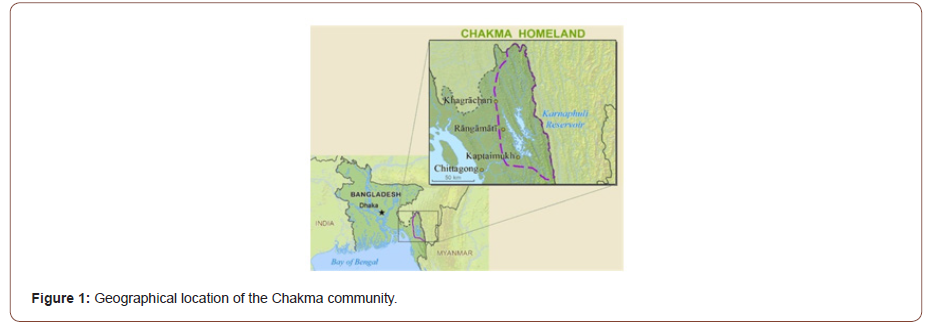
Groundwork of the Chakma cloth weaving: Traditionally, they use cotton (Figure 2) and produced that in the hilly slopes from jhum cultivation for making the yarn for weaving. The cotton would be removed from the pod and brought into the house and thoroughly cleaned. It was then spread out on mats and left to dry in the sun for two or three days. The dry cotton was then ginned to remove the seeds and to make them soft. Afterward, it was rolled by hand onto little pieces of bamboo. It was further refined by being rolled on a rod called pech, before being spun into yarn with the charka or spinning wheel (Figure 3). Though these days, most yarn is purchased from the market. However, on the occasion of Kathin Chibar Dan, cotton is still picked traditionally and spun into yarn before being woven into cloth. All this takes place within 24 hours, with groups of women working around the cloth.
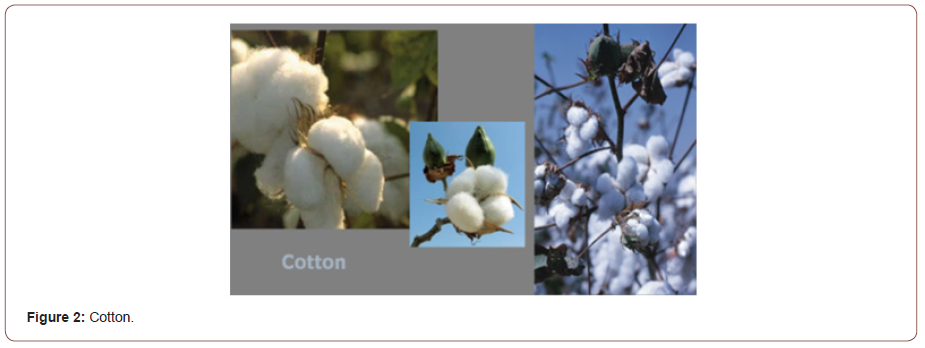
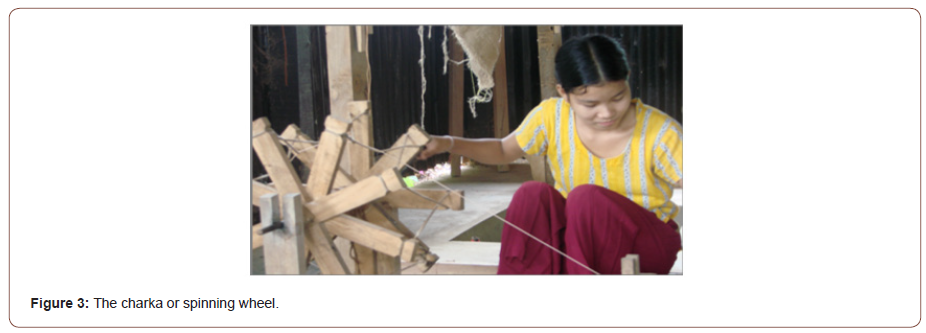
Dyeing: Chakma community lives in a very colorful natural environment. So, colors widely exist in their artisan work and reflect in every sphere of their lives [11]. Particularly, in their dresses, mountainous colorful features are even more naturally displayed.
The next step involved dyeing the yarn with natural dyes. Thus, red dye is prepared from the root of the rong gachh tree and black dye is obtained by boiling the bark of the kala gab tree. For blue dye, they use indigo leaves and are placed in an earthen vessel. The leaves are usually covered with water and let soak for two days. A yellow dye is mainly prepared by mixing turmeric and the bark of a mango tree. After that, the yarn is buried in the soft mud beside the river to make it colorfast.
The next step involved dyeing the yarn with natural dyes. Thus, red dye is prepared from the root of the rong gachh tree and black dye is obtained by boiling the bark of the kala gab tree. For blue dye, they use indigo leaves and are placed in an earthen vessel. The leaves are usually covered with water and let soak for two days. A yellow dye is mainly prepared by mixing turmeric and the bark of a mango tree. After that, the yarn is buried in the soft mud beside the river to make it colorfast.
Yarn processing: The next step involves laying out the yarn in preparation for weaving. This is known as tana deya in Bangla or bain bajat in Chakma. To layout the yarn, several lengths of bamboo are stuck in the ground. The round bamboo at the two ends is known as bainokhuda (Figure 4). When the laying of the warp is complete, they will be replaced by the Tambo bash and Tagalog bash. Next to
the bainokhuda on the left of the warp layer is the lablebi. Next to the lablebi is the round Bogla bash which will be substituted by the thinner ajaju when the warp is taken up and attached to the loom. Next to the bainokhuda on the right of the warp layer is the siyong. This will help the warp to retain its tension when the weaving is being done. The yarn is wound around the bainokhuda, the lablebi and the siyong, two threads at a time. While winding the strands for the warp around the bainokhuda, the person preparing the warp twists a different colored yarn around the Bogla bash for the weaver to an alternate layer of the warp while weaving. When a sufficient amount of warp has been prepared, the whole is taken up. The Tambo bash replaces the bainokhuda at the far end of the loom. It is then tied with ropes to the bainokhuda in the verandah or under a tree below which the weaving will take place. The other end of the warp is attached to the Tagalog bash, which is attached to the tachhi sam, the leather strap which will go over the shoulders of the weaver and rest on the small of her back when she sits down to weave.
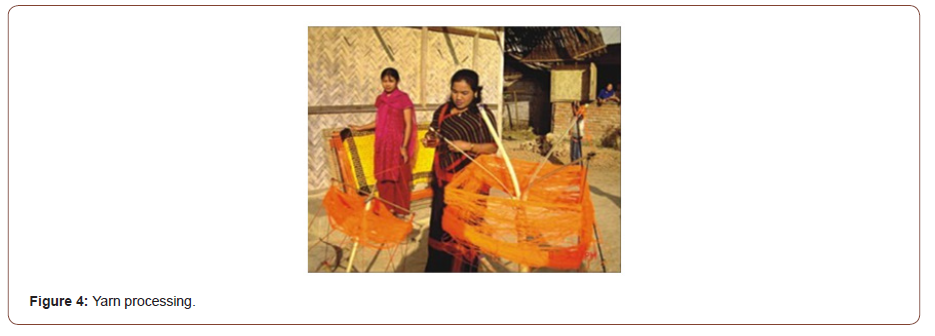
The loom preparation: The most well-known back strap loom is called ‘Bain’ (Figure 5). It has twelve main parts, nearly all made from bamboo, rope, a piece of leather, and the chew betel nut tree. Chakma Manjulika describes different parts of the loom which have different names and different functions (Table 1) [12]. In addition to those materials, the weaver also needs wax and as well as sufficient water. The wax is passed along the yarn to stiffen it for weaving and water is necessary for cotton, sprinkled on the cloth.
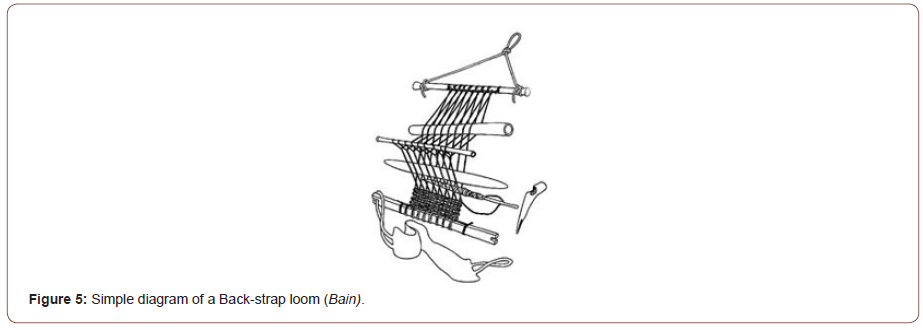
Table 1:Description of different loom parts.
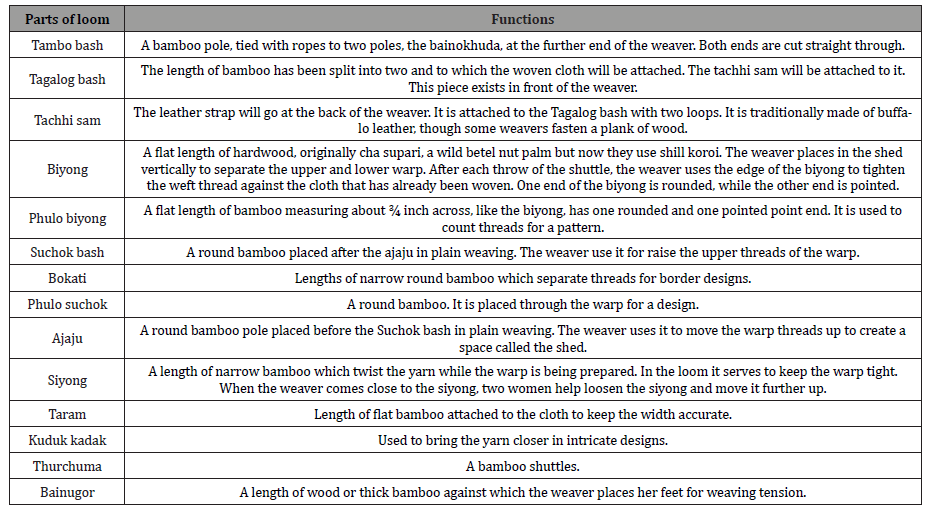
The weaving processes: Mainly Chakma women play the role of weaving cloths by their back-strap loom at the courtyard of the house (Figure 6). Once the yarn has been fastened to the loom, the weaver sits down, her legs straight in front against the bainugor, footrest. She fixes the back strap behind her waist. To weave, the weaver moves the warp threads up or down with the help of the ajaju, creating a space called the shed. The biyong is placed in the shed vertically. The weaver then passes the shuttle, known as thurchuma, through the shed. Then she uses the flat edge of the biyong to beat the weft thread against the woven cloth. The biyong is taken out and the Suchok bash is used to reverse the threads of the warp. With the help of the ajaju, a fresh shed is created between the threads which have become reversed. The biyong is replaced in the shed vertically and the shuttle passed from left to right. When the weaving begins, the split tagalong bash works as the first weft. The process continues in this way for plain weaving.

Motifs in Chakma cloths
Every Chakma girl is taught weaving by her mother and elders. At about eight years of age, a girl is encouraged to start learning a range of designs, which her mother shows her from an heirloom woven catalog, named the Alam (Figure 7) [13]. In Chakma clothing, a total of 210 motifs (Alam) exists since age long. Most Alam designs are drawn from nature (flower, tree, reptiles, birds, and animals). The skill of weaving motifs in clothing is considered a qualification of a good wife and a spiritual value.
There are hundreds of motifs that a good weaver must learn. Some of the most famous designs are given in the following Table 2.

Table 2:List of traditional motifs.

Outfits of Chakmas’
It is the women who maintain the traditional Chakma style of dress, which consists of two pieces of cloth. One is worn as a skirt (pinon), wrapped around the lower part of the body and extending from waist to ankle. Its traditional color is black with fine lines of dark blue and red bands, known as pale, towards the top and the bottom of the garment. The second piece of cloth is a breastband (Hadi), woven with colored designs that are tightly wrapped around the upper body (Figure 8).

Moreover, they also wear the siloom, a loose, stitched upper garment, was generally worn when they went to the forest for jhum cultivation or to collect twigs. The khabang is a long piece of cloth worn around the head. With the increasing number of Bengali inhabitants in the Chittagong Hill Tracts area, Chakma women began feeling uncomfortable with their usual outfits in public places [14]. Therefore, these days to counteract the gaze of the outsider, in urban areas they started adding an upper garment to their traditional wear, a blouse. This is worn with a variety of necklaces, bracelets, anklets, rings, and other ornaments (Figure 9). Jewelry used by the Chakma women includes various ornaments made of coins, metal, and locally available flowers. Nowadays in urban areas, instead of traditional clothes Chakma men usually wear western-style shirts and trousers but in rural areas, many continue to wear knee-length dhuti or lungis (sarongs).
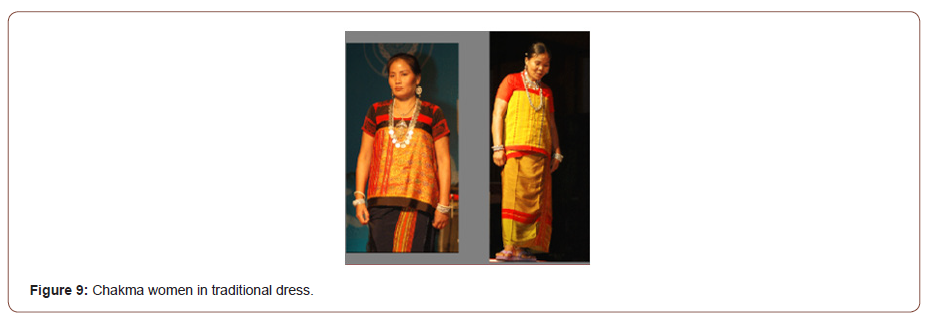
Festivals clothing of Chakma
The festivals are the central part of the Chakma tribe and that is their lifestyle. As the vast majority of Chakmas are Buddhists, so they celebrate various Buddhist festivals. The most important is Buddha Purnima. This is the anniversary of three important events: Buddha’s birth, his attainment of enlightenment (nirvana), and his death (parinirvana). Buddha Purnima observed on the full moon day of the month of Boishakh and wearing a traditional costume is the part of the festival [15]. As part of rituals, they light thousands of lamps, the release of Phanuch Batti (an auspicious lamp made of paper in the form of a balloon) is also done. On this festival day, Chakmas put on their best clothes and visit the temple [16].
Bizu is the most important socio-religious festival of the Chakma. The festival lasts for three days and begins on the last day of the month of Choitra. The first day is known as Phool Bizu and the day starts with a bath in the early morning and offers flowers to the river. And Chakma girls wear a traditional colored dress (Figure 10). The traditional color of pinon is black with fine lines of dark blue and red bands. They wear traditional scurf called Hadi and blouse both are red. The second day known as Mul Bizu or one day before New Year’s Eve (Choitro Shongkranti) day starts with the bath in the early morning. People wear new traditional clothes and pay visits to different houses in the village. The day ends with Bizu song and Bizu dance. The third day of the festival is called Gojjepojje din and that is the first day of Boishak. On that day children and adults go out wearing new colorful traditional dresses and bathing the elders to get their blessings. They also go to the monastery to offer their prayers.
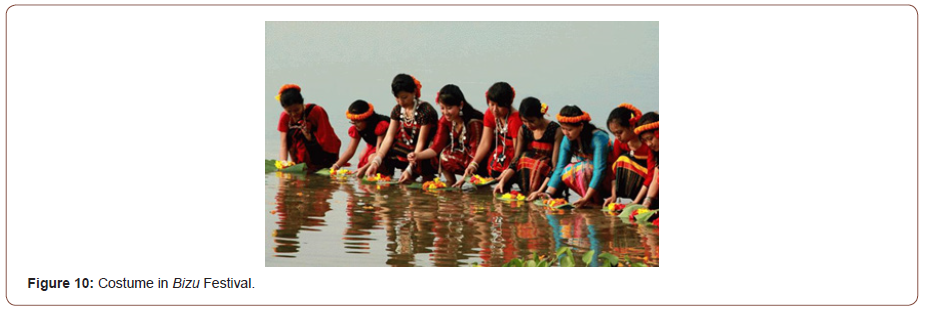
Kothin Chibor dan is another main religious festival of the Chakma community. On that festival day, people respect Buddhist monks by offering chibor (ceremonial cloth) gifts. Women make that chibor in a very traditional way. They collect jhum cotton, spin the cotton into yarn, collect natural dye, dye yarn, dry the yarn, weave into the cloth and sew the cloth into a ceremonial dress and present that chibor to the monk. After receiving that robe (chibor) monks left their old robe and wear a new robe.
Conclusion
In the study, it is found that the Chakma ethnic tribe had a remarkable traditional fashion and it is different from the other tribes of the region. Tribal folk is creating their own beauty with their vision and style. This wild-flower beauty is seen only in the mountainous southeastern zone of Bangladesh. However, fashion designers and new entrepreneurs are trying to gain inspiration from tribal culture, which has become a fad among the young generation for innovative concepts. Their efforts hopefully will be recognized across the world, as well as explore this rich culture and heritage of Bangladesh.
To read more about this article....Open access Journal of Textile Science & Fashion Technology
Please follow the URL to access more information about this article
To know more about our Journals...Iris Publishers





No comments:
Post a Comment